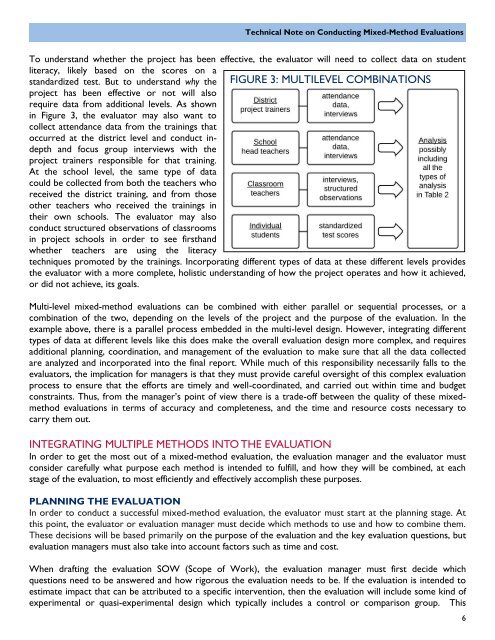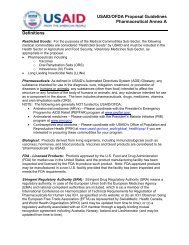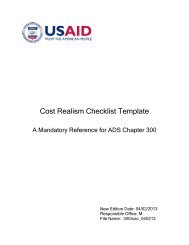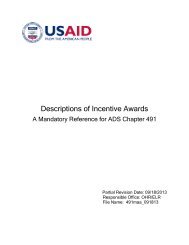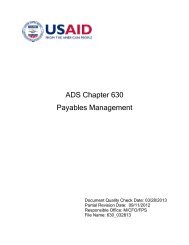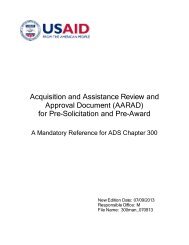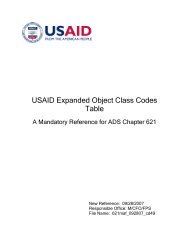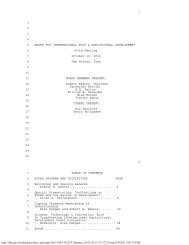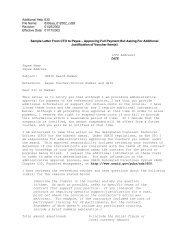Technical Note: Conducting Mixed Method Evaluations - usaid
Technical Note: Conducting Mixed Method Evaluations - usaid
Technical Note: Conducting Mixed Method Evaluations - usaid
Create successful ePaper yourself
Turn your PDF publications into a flip-book with our unique Google optimized e-Paper software.
<strong>Technical</strong> <strong>Note</strong> on <strong>Conducting</strong> <strong>Mixed</strong>-<strong>Method</strong> <strong>Evaluations</strong><br />
To understand whether the project has been effective, the evaluator will need to collect data on student<br />
literacy, likely based on the scores on a<br />
standardized test. But to understand why the FIGURE 3: MULTILEVEL COMBINATIONS<br />
project has been effective or not will also<br />
require data from additional levels. As shown<br />
in Figure 3, the evaluator may also want to<br />
collect attendance data from the trainings that<br />
occurred at the district level and conduct indepth<br />
and focus group interviews with the<br />
project trainers responsible for that training.<br />
At the school level, the same type of data<br />
could be collected from both the teachers who<br />
received the district training, and from those<br />
other teachers who received the trainings in<br />
their own schools. The evaluator may also<br />
conduct structured observations of classrooms<br />
in project schools in order to see firsthand<br />
whether teachers are using the literacy<br />
techniques promoted by the trainings. Incorporating different types of data at these different levels provides<br />
the evaluator with a more complete, holistic understanding of how the project operates and how it achieved,<br />
or did not achieve, its goals.<br />
Multi-level mixed-method evaluations can be combined with either parallel or sequential processes, or a<br />
combination of the two, depending on the levels of the project and the purpose of the evaluation. In the<br />
example above, there is a parallel process embedded in the multi-level design. However, integrating different<br />
types of data at different levels like this does make the overall evaluation design more complex, and requires<br />
additional planning, coordination, and management of the evaluation to make sure that all the data collected<br />
are analyzed and incorporated into the final report. While much of this responsibility necessarily falls to the<br />
evaluators, the implication for managers is that they must provide careful oversight of this complex evaluation<br />
process to ensure that the efforts are timely and well-coordinated, and carried out within time and budget<br />
constraints. Thus, from the manager’s point of view there is a trade-off between the quality of these mixedmethod<br />
evaluations in terms of accuracy and completeness, and the time and resource costs necessary to<br />
carry them out.<br />
INTEGRATING MULTIPLE METHODS INTO THE EVALUATION<br />
In order to get the most out of a mixed-method evaluation, the evaluation manager and the evaluator must<br />
consider carefully what purpose each method is intended to fulfill, and how they will be combined, at each<br />
stage of the evaluation, to most efficiently and effectively accomplish these purposes.<br />
PLANNING THE EVALUATION<br />
In order to conduct a successful mixed-method evaluation, the evaluator must start at the planning stage. At<br />
this point, the evaluator or evaluation manager must decide which methods to use and how to combine them.<br />
These decisions will be based primarily on the purpose of the evaluation and the key evaluation questions, but<br />
evaluation managers must also take into account factors such as time and cost.<br />
When drafting the evaluation SOW (Scope of Work), the evaluation manager must first decide which<br />
questions need to be answered and how rigorous the evaluation needs to be. If the evaluation is intended to<br />
estimate impact that can be attributed to a specific intervention, then the evaluation will include some kind of<br />
experimental or quasi-experimental design which typically includes a control or comparison group. This<br />
6


